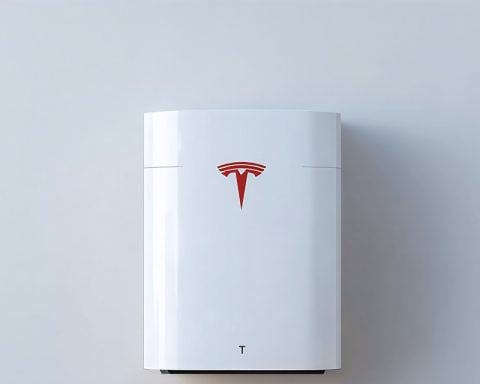- BYD aims to unveil solid-state battery demos by 2027, potentially revolutionizing electric vehicle technology.
- These batteries offer enhanced energy density, improving driving range and charging speed for EVs.
- Solid-state batteries could surpass liquid batteries in efficiency and convenience.
- Challenges remain in mass production, with companies like CATL, Honda, Toyota, and Volkswagen also pursuing this technology.
- BYD’s innovative strides position it as a leader in the battery industry, with solid-state batteries expected to be more commonplace by 2030.
- The advancements in solid-state batteries are set to contribute to a more sustainable automotive industry.
Amid a landscape charged with innovation, China’s automotive powerhouse BYD is steering towards a quantum leap in electric vehicle technology. The company has set its sights on 2027 for unveiling its pioneering solid-state battery demos, a move that may redefine the future of electric mobility.
This ambitious endeavor, spearheaded by BYD’s Chief Technical Officer Sun Huajun, promises a revolutionary enhancement in energy density. These avant-garde solid-state batteries pledge to catapult electric vehicle performance with remarkable gains in driving range and swifter charging capabilities. As these batteries inch closer to becoming economically viable, they hold the potential to outperform their liquid counterparts, ushering in a new era of efficiency and convenience for drivers worldwide.
Yet, the road to mass production remains intricate, adorned with challenges that manufacturers like CATL—BYD’s formidable rival—are also grappling with. Despite these hurdles, the industry is fervently synchronizing its efforts, with numerous giants such as Honda, Toyota, and Volkswagen in pursuit of this transformative technology.
BYD’s commitment to innovation secures its position at the forefront of the battery revolution. As the world’s second-largest battery producer, its ambitious targets align with a broader industry anticipation where, by 2030, solid-state batteries might transition from groundbreaking prototypes to everyday reality.
The race to harness this electrifying future is on, and as these advancements race towards fruition, they promise not just to light up dashboards but to illuminate a path towards a more sustainable automotive industry. Keep your eyes on 2027 as the year the spark truly ignites.
The Electric Future: How BYD’s Solid-State Battery Revolution Could Change Driving Forever
How Solid-State Batteries Work: A Key to the Future
The transition from traditional lithium-ion batteries to solid-state batteries represents a monumental leap in electric vehicle (EV) technology. Solid-state batteries replace the liquid electrolyte found in lithium-ion batteries with a solid material, which increases energy density, enhances safety, and enables faster charging times. This shift is anticipated to extend driving ranges and improve battery lifespan, making EVs more appealing and practical.
How-To Steps & Life Hacks:
– Understand the Benefits: Solid-state batteries offer higher energy density, leading to greater range for EVs. This means fewer stops for charging and more freedom on the road.
– Anticipate the Changes: Expect the evolution of EV infrastructure, such as more rapid charging stations, as these batteries become more prevalent.
– Prepare Your Home: Consider upgrading your home charging setup to be compatible with faster-charging technologies that solid-state batteries can support.
Real-World Use Cases: Solidifying the Future
In the coming years, industries beyond automotive, like aviation and consumer electronics, will likely harness solid-state battery technology for its efficiency and safety characteristics. For instance, aviation companies could use these batteries to power hybrid or fully electric aircraft, reducing carbon footprints.
Market Forecasts & Industry Trends
Experts predict that by 2030, solid-state batteries could dominate the EV market, thanks to their superior performance. According to a report from MarketsandMarkets, the solid-state battery market size is expected to reach USD 1.1 billion by 2025, highlighting significant industry growth.
Reviews & Comparisons: The BYD Standpoint
BYD, as the world’s second-largest battery producer, is in fierce competition with other giants like CATL and is leveraging its robust R&D capabilities. While companies like Toyota and Volkswagen are also making strides, BYD’s timeline for 2027 gives them a competitive edge if achieved.
Controversies & Limitations
Challenges remain in scaling production due to high costs and manufacturing complexities. While promising, solid-state batteries are not yet fully immune to issues faced by lithium-ion counterparts, such as resource sourcing and thermal management.
Features, Specs & Pricing Potential
While specific pricing for solid-state batteries has yet to be released, costs are expected to be higher initially due to the nascent technology and production challenges. However, economies of scale and technological advancements are anticipated to drive costs down over time.
Security & Sustainability Insights
Solid-state batteries offer improved safety features over lithium-ion batteries as they are less prone to overheating and combustion. Additionally, their potential longevity and efficiency align with global sustainability goals.
Tutorials & Compatibility for EV Owners
As solid-state batteries become common, tutorials on maximizing battery life and optimizing performance will help EV owners. It’s vital to keep vehicle software updated and learn best charging practices.
Pros & Cons Overview
Pros:
– Higher energy density and improved safety.
– Faster charging capabilities.
– Longer lifespan and sustainability.
Cons:
– High initial cost.
– Complex manufacturing process.
– Production scalability challenges.
Actionable Recommendations
– Stay Informed: Keep an eye on industry updates about solid-state battery releases and new compatible EV models.
– Invest Wisely: Consider long-term benefits when purchasing an EV. Models with solid-state batteries could offer better value over time.
– Plan for Transition: Adjust personal or business operations to accommodate future EV technologies for seamless adoption.
For more information about BYD and their initiatives, visit BYD.
This revolutionary shift in the automotive industry is poised to reshape mobility standards, offering cleaner and more efficient driving alternatives. As 2027 approaches, preparation and knowledge will be key to capitalizing on the opportunities solid-state batteries present.













